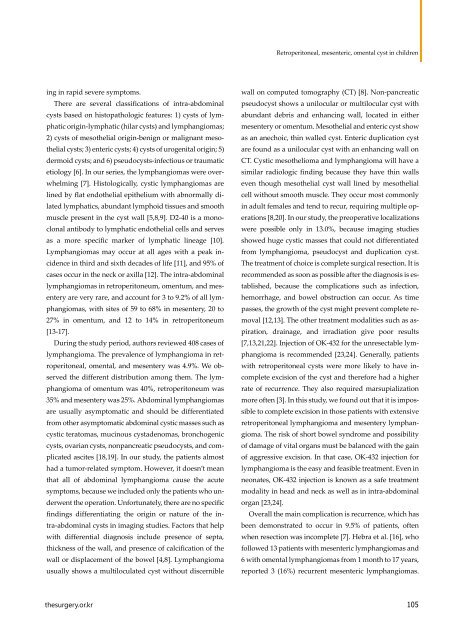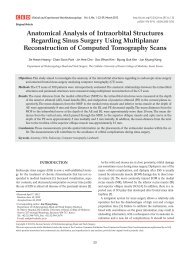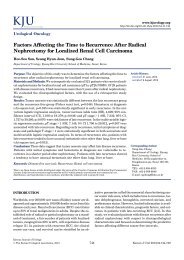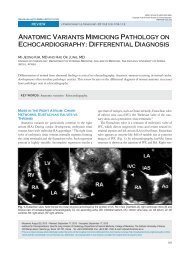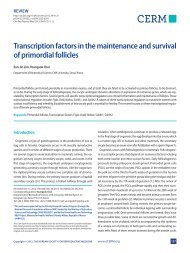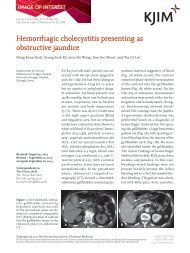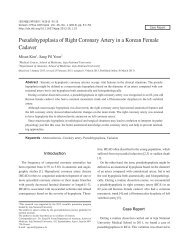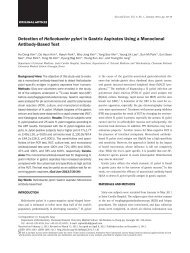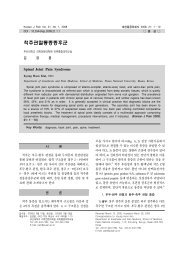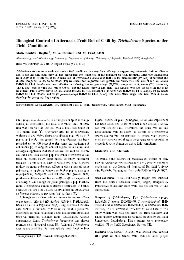The surgical experience for retroperitoneal, mesenteric and omental ...
The surgical experience for retroperitoneal, mesenteric and omental ...
The surgical experience for retroperitoneal, mesenteric and omental ...
You also want an ePaper? Increase the reach of your titles
YUMPU automatically turns print PDFs into web optimized ePapers that Google loves.
ing in rapid severe symptoms.<br />
<strong>The</strong>re are several classifications of intra-abdominal<br />
cysts based on histopathologic features: 1) cysts of lymphatic<br />
origin-lymphatic (hilar cysts) <strong>and</strong> lymphangiomas;<br />
2) cysts of mesothelial origin-benign or malignant mesothelial<br />
cysts; 3) enteric cysts; 4) cysts of urogenital origin; 5)<br />
dermoid cysts; <strong>and</strong> 6) pseudocysts-infectious or traumatic<br />
etiology [6]. In our series, the lymphangiomas were overwhelming<br />
[7]. Histologically, cystic lymphangiomas are<br />
lined by flat endothelial epithelium with abnormally dilated<br />
lymphatics, abundant lymphoid tissues <strong>and</strong> smooth<br />
muscle present in the cyst wall [5,8,9]. D2-40 is a monoclonal<br />
antibody to lymphatic endothelial cells <strong>and</strong> serves<br />
as a more specific marker of lymphatic lineage [10].<br />
Lymphangiomas may occur at all ages with a peak incidence<br />
in third <strong>and</strong> sixth decades of life [11], <strong>and</strong> 95% of<br />
cases occur in the neck or axilla [12]. <strong>The</strong> intra-abdominal<br />
lymphangiomas in retroperitoneum, omentum, <strong>and</strong> mesentery<br />
are very rare, <strong>and</strong> account <strong>for</strong> 3 to 9.2% of all lymphangiomas,<br />
with sites of 59 to 68% in mesentery, 20 to<br />
27% in omentum, <strong>and</strong> 12 to 14% in retroperitoneum<br />
[13-17].<br />
During the study period, authors reviewed 408 cases of<br />
lymphangioma. <strong>The</strong> prevalence of lymphangioma in <strong>retroperitoneal</strong>,<br />
<strong>omental</strong>, <strong>and</strong> mesentery was 4.9%. We observed<br />
the different distribution among them. <strong>The</strong> lymphangioma<br />
of omentum was 40%, retroperitoneum was<br />
35% <strong>and</strong> mesentery was 25%. Abdominal lymphangiomas<br />
are usually asymptomatic <strong>and</strong> should be differentiated<br />
from other asymptomatic abdominal cystic masses such as<br />
cystic teratomas, mucinous cystadenomas, bronchogenic<br />
cysts, ovarian cysts, nonpancreatic pseudocysts, <strong>and</strong> complicated<br />
ascites [18,19]. In our study, the patients almost<br />
had a tumor-related symptom. However, it doesn’t mean<br />
that all of abdominal lymphangioma cause the acute<br />
symptoms, because we included only the patients who underwent<br />
the operation. Un<strong>for</strong>tunately, there are no specific<br />
findings differentiating the origin or nature of the intra-abdominal<br />
cysts in imaging studies. Factors that help<br />
with differential diagnosis include presence of septa,<br />
thickness of the wall, <strong>and</strong> presence of calcification of the<br />
wall or displacement of the bowel [4,8]. Lymphangioma<br />
usually shows a multiloculated cyst without discernible<br />
Retroperitoneal, <strong>mesenteric</strong>, <strong>omental</strong> cyst in children<br />
wall on computed tomography (CT) [8]. Non-pancreatic<br />
pseudocyst shows a unilocular or multilocular cyst with<br />
abundant debris <strong>and</strong> enhancing wall, located in either<br />
mesentery or omentum. Mesothelial <strong>and</strong> enteric cyst show<br />
as an anechoic, thin walled cyst. Enteric duplication cyst<br />
are found as a unilocular cyst with an enhancing wall on<br />
CT. Cystic mesothelioma <strong>and</strong> lymphangioma will have a<br />
similar radiologic finding because they have thin walls<br />
even though mesothelial cyst wall lined by mesothelial<br />
cell without smooth muscle. <strong>The</strong>y occur most commonly<br />
in adult females <strong>and</strong> tend to recur, requiring multiple operations<br />
[8,20]. In our study, the preoperative localizations<br />
were possible only in 13.0%, because imaging studies<br />
showed huge cystic masses that could not differentiated<br />
from lymphangioma, pseudocyst <strong>and</strong> duplication cyst.<br />
<strong>The</strong> treatment of choice is complete <strong>surgical</strong> resection. It is<br />
recommended as soon as possible after the diagnosis is established,<br />
because the complications such as infection,<br />
hemorrhage, <strong>and</strong> bowel obstruction can occur. As time<br />
passes, the growth of the cyst might prevent complete removal<br />
[12,13]. <strong>The</strong> other treatment modalities such as aspiration,<br />
drainage, <strong>and</strong> irradiation give poor results<br />
[7,13,21,22]. Injection of OK-432 <strong>for</strong> the unresectable lymphangioma<br />
is recommended [23,24]. Generally, patients<br />
with <strong>retroperitoneal</strong> cysts were more likely to have incomplete<br />
excision of the cyst <strong>and</strong> there<strong>for</strong>e had a higher<br />
rate of recurrence. <strong>The</strong>y also required marsupialization<br />
more often [3]. In this study, we found out that it is impossible<br />
to complete excision in those patients with extensive<br />
<strong>retroperitoneal</strong> lymphangioma <strong>and</strong> mesentery lymphangioma.<br />
<strong>The</strong> risk of short bowel syndrome <strong>and</strong> possibility<br />
of damage of vital organs must be balanced with the gain<br />
of aggressive excision. In that case, OK-432 injection <strong>for</strong><br />
lymphangioma is the easy <strong>and</strong> feasible treatment. Even in<br />
neonates, OK-432 injection is known as a safe treatment<br />
modality in head <strong>and</strong> neck as well as in intra-abdominal<br />
organ [23,24].<br />
Overall the main complication is recurrence, which has<br />
been demonstrated to occur in 9.5% of patients, often<br />
when resection was incomplete [7]. Hebra et al. [16], who<br />
followed 13 patients with <strong>mesenteric</strong> lymphangiomas <strong>and</strong><br />
6 with <strong>omental</strong> lymphangiomas from 1 month to 17 years,<br />
reported 3 (16%) recurrent <strong>mesenteric</strong> lymphangiomas.<br />
thesurgery.or.kr 105


